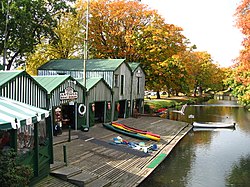| Antigua Boat Sheds | |
|---|---|
 | |
 | |
| General information | |
| Location | 43°32′02″S172°37′41″E / 43.533831°S 172.627995°E |
| Address | 2 Cambridge Terrace |
| Town or city | Christchurch |
| Country | New Zealand |
| Construction started | 1882 |
| Completed | 1883 |
| Design and construction | |
| Architect(s) | Albert Shaw and J T Tidd |
| Designated | 10 September 2004 |
| Reference no. | 1825 |
The Antigua Boat Sheds in Christchurch, New Zealand is an historic building on the banks of the Avon River. [1] It is possibly the only 19th-century example of a commercial boat shed situated on a river in New Zealand. It has been used as a boat shed continuously since its completion in 1882. [2]

